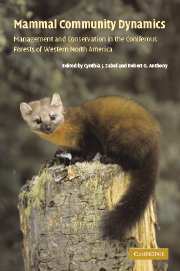 Mammal Community Dynamics
Mammal Community Dynamics Book contents
- Frontmatter
- Contents
- List of contributors
- Foreword
- Acknowledgments
- Part I Management and conservation issues for various taxa
- Part II Community and ecosystem relations
- Part III Conservation issues and strategies
- 16 Small mammals in a landscape mosaic: implications for conservation
- 17 Measuring and interpreting connectivity for mammals in coniferous forests
- 18 An evolutionary and behavioral perspective on dispersal and colonization of mammals in fragmented landscapes
- 19 The functional diversity of mammals in coniferous forests of western North America
- 20 Synopsis and future perspective
- Index
- References
19 - The functional diversity of mammals in coniferous forests of western North America
Published online by Cambridge University Press: 15 December 2009
- Frontmatter
- Contents
- List of contributors
- Foreword
- Acknowledgments
- Part I Management and conservation issues for various taxa
- Part II Community and ecosystem relations
- Part III Conservation issues and strategies
- 16 Small mammals in a landscape mosaic: implications for conservation
- 17 Measuring and interpreting connectivity for mammals in coniferous forests
- 18 An evolutionary and behavioral perspective on dispersal and colonization of mammals in fragmented landscapes
- 19 The functional diversity of mammals in coniferous forests of western North America
- 20 Synopsis and future perspective
- Index
- References
Summary
The ecological knowledge needed to achieve the goals of ecosystem management will not be limited to understanding the influence of habitat manipulations on desired mammal populations; it will also include an understanding of how those mammals contribute to the functioning of the ecosystems they occupy. Examples of the significant influence that mammals may have on the structure and function of ecosystems include the effects of sea otters (Enhydra lutris) on the community structure of coastal marine ecosystems (Estes and Palmisano 1974), the effects of American beavers (Castor canadensis) on the hydrology and ecology of temperate riparian ecosystems (Naiman et al. 1986, Anthony et al. 2003), the effects of burrowing mammals on soil fertility and stability (Meadows and Meadows 1991, Ayarbe and Kieft 2000), and the effects of large ungulates on successional processes and the structure of plant communities in a variety of ecosystems (Hobbs 1996). Each of these species or species groups has been described as a potential keystone species (Mills et al. 1993) in the ecosystems they occupy. Because most species of mammals may not influence ecosystem processes to the extent that keystone species do, their ecological contributions are often overlooked. We propose, however, that the collective importance of terrestrial mammals to ecosystem structure and function is substantial and that the decline or loss of forest mammal species could have detrimental effects on ecosystem diversity, productivity, or sustainability.
- Type
- Chapter
- Information
- Mammal Community DynamicsManagement and Conservation in the Coniferous Forests of Western North America, pp. 631 - 664Publisher: Cambridge University PressPrint publication year: 2003
References
- 4
- Cited by


